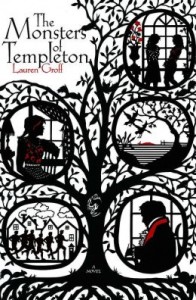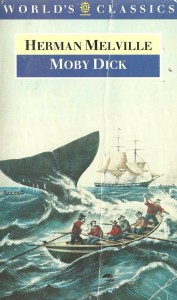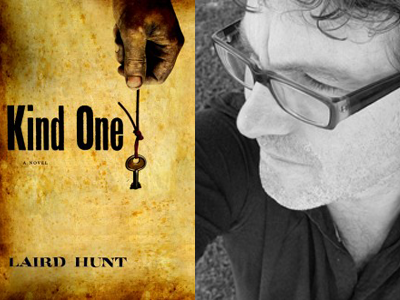Todd Summar
I first met Lauren Groff several years ago during her residency at Ragdale in Lake Forest, Illinois. She was still enjoying the praise for her debut novel, The Monsters of Templeton, had just released her short story collection, Delicate Edible Birds, and was working on her second novel, Arcadia. She was warm and friendly, possessing an impressive knowledge of writing and literature. She generously indulged my novice questions about her process, and offered candid anecdotes about the publishing industry. Her beautiful prose and expert story craftsmanship, whether in her novels or her stories that appear in places like The New Yorker, The Atlantic Monthly, Ploughshares, or Tin House, can serve as a model for writers of all genres.
 The Monsters of Templeton is a product of blending fact with fiction. Lauren used her own experience of a childhood growing up in Cooperstown, New York, fused it with author James Fenimore Cooper’s fictional version of Cooperstown first published in the 1800s, which he called Templeton, and invented her own version of Templeton, a hybrid between the two. She has admitted that she draws much of her inspiration from history, and from her own experiences and fears. The best fiction, according to her, can be crafted by bending the truth into a shape that best fits the story that the writer wants to tell. I recently asked Lauren to relive the events that led up to the creation of Monsters—the genesis of the idea, the research, the writing and revision process. As a writer myself, I wanted to conduct a more in-depth examination of how she gets the results that she does. As she had before, she generously agreed to pull back the curtain and allow me backstage.
The Monsters of Templeton is a product of blending fact with fiction. Lauren used her own experience of a childhood growing up in Cooperstown, New York, fused it with author James Fenimore Cooper’s fictional version of Cooperstown first published in the 1800s, which he called Templeton, and invented her own version of Templeton, a hybrid between the two. She has admitted that she draws much of her inspiration from history, and from her own experiences and fears. The best fiction, according to her, can be crafted by bending the truth into a shape that best fits the story that the writer wants to tell. I recently asked Lauren to relive the events that led up to the creation of Monsters—the genesis of the idea, the research, the writing and revision process. As a writer myself, I wanted to conduct a more in-depth examination of how she gets the results that she does. As she had before, she generously agreed to pull back the curtain and allow me backstage.
Todd Summar: The Monsters of Templeton balances multiple characters’ voices through various formats to tell a story that unfolds over two hundred years. How did you determine what points of view to follow, and through which formats (letters, journal entries, narrative)?
Lauren Groff: I started Monsters almost ten years ago, now, so the initial phase of the work feels more like a dream than a memory to me. Frankly, at the time, I was just enjoying the hell out of myself. When I’d wake up at dawn and spring out of bed to go work, I knew I was writing better. I knew the stories so well by then, and had compiled so many thousands of pages, that I could just fit the voices together like puzzle pieces. The final form they’re in came from the historical moment, the way that the voices were or weren’t going to be delivered to the protagonist Willie, and the dictates of what had come before, more than anything.
TS: You’ve said that the book didn’t work structurally until the fourth draft, after years of writing. What structural issues did you face in the first three drafts, and how did you solve them in the fourth?
LG: I tend to write ten pages for every page that I end up keeping. With novels, I start with research, and when I move on to writing, I’m not writing to keep the words I’m putting down—I’m trying to suss out what it is that I’m thinking and where I’m going. I’m afraid of outlining. My sketching is really just the many drafts it takes before I can write a good draft. I’ll try to choose a path to follow, follow it to the end, and end up having known most of the way there that the book was never going to work the way I had conceived of it. But it’s valuable for me to come to the end of a draft, because it teaches me about the story and the characters. The metaphor I use is of a three-dimensional printer: you just add layer to layer, until you create a three-dimensional story in your mind, and you can choose the way you’re going to want to write the book in the end. With this book, my previous drafts were difficult because I chose the wrong voices to narrate, or the wrong historical times to talk about, or the story was far too straightforwardly realistic. When I gave up the idea of publishing and let myself just have fun, the story worked better.
TS: How do you move from draft to draft?
LG: By then, I’d learned not to salvage anything, and I just started over. This is a beautiful thing for my process because if it’s important to the story, I’ll remember it. I almost always do it better the second time. I know because there are times I’m discouraged by the eighth or fifteenth time I’ve tried to say something, and I go back to look at the way I did it before, and I’m always profoundly irritated by the previous version, scene, or wording. It’s more efficient for me to just press ahead.
TS: What are the most effective steps in your revision process?
LG: First, taking the fourth or fiftieth draft, which is always in longhand, and putting it on the computer. There’s something about computer typescript that seems so similar to actual typescript that it changes the words. Then I read aloud, get feedback (which always involves a lot of time, because my readers are busy, so it counts as putting it in a drawer and returning to it later), crying. I also love doing a series of passes in which I have only one objective during that pass. For instance, if that pass is for dialogue, I’ll take a green pen, go through from bow to stern, correcting only dialogue. I’ll do the same thing with each character, with language, with cutting ten percent, with cutting an additional ten percent after that, with putting in echoes, and on and on. I end up having fifteen colors of pen-markings on that draft.
TS: The Monsters of Templeton was an ambitious undertaking, packing in layers of story in a relatively small amount of space. In this and much of your other work, you play with historical facts and fictional characters from classic literature. What novels and authors inspired the novel?
LG: I’ve always been a hungry reader, and among the many books that inspired Monsters, there were two that are clear and still urgent. One was The Pioneers by James Fenimore Cooper, which was particularly important because Cooper came from Cooperstown—his father, William Cooper, started up the town—but also because he started the legacy of calling Cooperstown a fictional Templeton in his books. For Monsters, I’ve stolen many of his characters and even one scene, which I totally rewrote from another character’s point of view and sensibility [Natty Bumppo, who later appeared in Cooper’s well-known The Last of the Mohicans].
 The second was Moby-Dick by Herman Melville, which I read after having finished three whole drafts of my story and feeling unsatisfied and a little bit worn down. I was pretty sure I’d never write a publishable draft. And then I read that great, insane book and felt liberated to write my story as insanely as I could; why not? That’s how my lake monster was born, and it happened to be as close to my idea for the book as I could end up coming.
The second was Moby-Dick by Herman Melville, which I read after having finished three whole drafts of my story and feeling unsatisfied and a little bit worn down. I was pretty sure I’d never write a publishable draft. And then I read that great, insane book and felt liberated to write my story as insanely as I could; why not? That’s how my lake monster was born, and it happened to be as close to my idea for the book as I could end up coming.
TS: You’ve noted that you wrote a few failed “test novels” before Monsters, and that you were reluctant to even call yourself a writer, telling friends as an undergrad that you planned to become a pediatrician. What changed that for you, empowering you with the confidence to call yourself a writer?
LG: I have lots of failed novels. It’s good to have failed novels. The only thing I can imagine that changed for me was that in college, I started dating the man who’d become my husband. He was so sensible and kind and generous and able to make a salary that when I asked him if he wouldn’t mind supporting me for the rest of our lives as I eked out a tiny living writing the things I wanted to write, he liked me enough to say sure. That’s the biggest possible gift anyone could give a writer—freedom from a 40-hour-per-week job.
TS: Monsters contains many visual components—photographs, maps, family trees—that lend credibility to Willie’s research. Where did these elements originate?
LG: I’m the world’s worst visual artist. When I’d given up on publishing the book, I spent a frustrating writing day making the image of Glimmey at the University of Wisconsin library. It was fun and relieved some kind of pressure, and I laughed like a fiend to do it. Also, the photographs are either of my family and friends or are images that I bought on eBay, especially Marmaduke, who hangs over my dining room and freaks people out. He’s big and dark and sneering at our food. I think that painting is haunted.
TS: When Monsters was first released in 2008, you described yourself as a literary writer. Although the book plays with genre elements, and was endorsed by Stephen King, your concern was that it is harder for young, new writers to dabble in genre or go back and forth. Do you think anything has changed over the years? Is the literary world becoming more open to the blending of genres?
LG: I think I was probably too frank, and I think it doesn’t actually matter. It’s difficult enough to survive no matter what you write, honestly, and we should probably all be just concerned with writing the best things we can and letting other people worry about genre. I think, truly, nobody cares anymore. I don’t!
TS: The beginning of your career was atypical for most young writers. When you were in graduate school, The Atlantic published your story “L. Debard and Aliette,” you then signed with your first agent, Bill Clegg (who had recovered from a highly publicized battle with drug abuse), and then published Monsters. Looking back, what are your thoughts on this trajectory?
LG: I got very lucky, in a way that doesn’t often happen to equally deserving writers, by having my story pulled from the slush pile at The Atlantic. I feel tremendously grateful. Also, that Bill was just then coming back to agenting after his disaster, and he needed clients, and was willing to fly to Louisville to ask me to be his client. Everyone who meets Bill falls in love. I’m no exception.
 TS: You live outside the epicenter of the literary world, in Gainesville, FL. Has that setting influenced your writing, or would your themes and content be the same wherever you live?
TS: You live outside the epicenter of the literary world, in Gainesville, FL. Has that setting influenced your writing, or would your themes and content be the same wherever you live?
LG: I live outside the literary world?!? WHAT? I joke! In truth, I spend ten hours of my day working or reading, which means that I’m invariably in places that may be imaginary, but are almost uniformly not Gainesville. The other fourteen hours are spent sleeping, eating, or playing with my children. It’s not that place doesn’t have an effect on me—it does, and it’s a major one—but right now, it’s the least of my concerns. I’m learning to handle Florida, and I would hate to live in Brooklyn, just because it’s so expensive, and I don’t actually want to have stressful literary conversations every day. I feel like an outsider, which is great because I think most writers begin to write because they feel like outsiders. Also, the last few years, Florida has been seeping into my fiction, as Florida tends to seep.
Todd Summar is a master’s candidate in fiction writing at Columbia College Chicago, where he serves as assistant coordinator for Story Week, one of Chicago’s largest literary festivals. He is the editor-in-chief of Goreyesque, an online journal featuring work inspired by Edward Gorey. He also works as a publicity intern for Curbside Splendor, a Chicago indie book publisher. His work is forthcoming in PANK Magazine. Follow him on Twitter at @ToddSummar.





